- Analyze Turkish educational system according to approaches you learned. Which one is the most effective? Explain why you think in this way.
 Education is the manner of learning or the acquiring of information, abilities, importance, faiths, and attitudes. The education method was growing powerful from ancient cultivation phase itself. Throughout the culture stage, people must analyze writing and reading to convey information from the individual to individual and from age to age. From that point, education is getting an essential piece of everyone’s living and yet, it proceeds and will endure eternally. Education is the primary element in everyone’s presence. Everyone needs to acquire primary education to survive in this community. Education is the scheme which implements specific purposes for the entire community. Variations are common in each generation, and while we cross from one generation to the following generation, we may encounter particular differences in the educational regularity.
Education is the manner of learning or the acquiring of information, abilities, importance, faiths, and attitudes. The education method was growing powerful from ancient cultivation phase itself. Throughout the culture stage, people must analyze writing and reading to convey information from the individual to individual and from age to age. From that point, education is getting an essential piece of everyone’s living and yet, it proceeds and will endure eternally. Education is the primary element in everyone’s presence. Everyone needs to acquire primary education to survive in this community. Education is the scheme which implements specific purposes for the entire community. Variations are common in each generation, and while we cross from one generation to the following generation, we may encounter particular differences in the educational regularity. Education is the transmitting and receiving of information within schooling and learning, particularly at a school or related establishment. The initial educational manners required partaking knowledge about collecting meals and implementing a place to stay, producing weaponry and distinct devices; acquiring the language; and earning the esteem, morals, and spiritual rituals or customs of a distributed culture. Before the discovery of reading and writing, humans survived in an atmosphere in which they strived to persist to life toward fundamental organizations, animals, and other humans. To remain, nonliterate people advanced professions that turned into social and enlightening exemplars. Education acquired from the human conflict for endurance and wisdom.
Education is the transmitting and receiving of information within schooling and learning, particularly at a school or related establishment. The initial educational manners required partaking knowledge about collecting meals and implementing a place to stay, producing weaponry and distinct devices; acquiring the language; and earning the esteem, morals, and spiritual rituals or customs of a distributed culture. Before the discovery of reading and writing, humans survived in an atmosphere in which they strived to persist to life toward fundamental organizations, animals, and other humans. To remain, nonliterate people advanced professions that turned into social and enlightening exemplars. Education acquired from the human conflict for endurance and wisdom.  It may be ceremonious or ordinary. Informal education leads to the common social manner by which people receive the information and abilities required to operate in their traditions. Formal education leads to the manner by which instructors teach learners in the fields of education in schools. Formally or informally every one of us are tutored. Education is the furnish with information. The overall improvement of subconscious, body, and spirit is the true teaching. Carter G. Woodson says about education that “For me, education means to inspire people to live more abundantly, to learn to begin with life as they find it and make it better. “Namely, it is necessary to assign the education to the pupil accurately. For this purpose, principally, methods in the education system ought to be discussed. Behaviorism, cognitive code learning, social-cognitive learning, and constructivism are one of the most prominent among these approaches.
It may be ceremonious or ordinary. Informal education leads to the common social manner by which people receive the information and abilities required to operate in their traditions. Formal education leads to the manner by which instructors teach learners in the fields of education in schools. Formally or informally every one of us are tutored. Education is the furnish with information. The overall improvement of subconscious, body, and spirit is the true teaching. Carter G. Woodson says about education that “For me, education means to inspire people to live more abundantly, to learn to begin with life as they find it and make it better. “Namely, it is necessary to assign the education to the pupil accurately. For this purpose, principally, methods in the education system ought to be discussed. Behaviorism, cognitive code learning, social-cognitive learning, and constructivism are one of the most prominent among these approaches.
 Firstly, what I have acquired is that behaviorism is based on perceptible functions. It demonstrates how all knowledge and habits are undeviatingly associated with environmental incentives. It implies that a student is typically inactive reacting to environmental inducements, and it may be an inducement prompting a reply by owning with it settled with a trigger. An illustration of this would be a dog salivating when they detect a ringing that he corresponds with food. The different idea of this theory is to compensate a withdrawal with producing inducements. A dog pushing a switch to deliver food would be an immeasurable case for this. Furthermore, a behaviorist does not consider that there is any disagreement among humans and animals because both can be disciplined by utilizing positive and negative awards. It concludes that a learner springs out with a blank schedule, and behavior is formed by positive and negative reinforcement. Reinforcement, positive or negative, improves the probability of an incident occurring repeatedly. Punishment, both positive and negative, reduce the opportunity of an issue occurring repeatedly. In this approach, educators present to the students’ direct feedback. They split down the assignments into petite assignments, they reproduce the inclinations as multiple times as reasonable and operate from the easiest to the various complicated assignments. They provide attention to positive reinforcement. Skinner maintained that positive reinforcement is more fruitful in shaping behavior than punishment. The teacher presents the inducement element and indicates for the accurate answer. Repetition and decent conditioning hold the pot loaded. Between the teaching approaches, drill task, repeated training, extra points, assistance features, and verbal reinforcement guide to limit brain strain. Therefore, education programs based on behaviorism may operate for some students but collapse for others.
Firstly, what I have acquired is that behaviorism is based on perceptible functions. It demonstrates how all knowledge and habits are undeviatingly associated with environmental incentives. It implies that a student is typically inactive reacting to environmental inducements, and it may be an inducement prompting a reply by owning with it settled with a trigger. An illustration of this would be a dog salivating when they detect a ringing that he corresponds with food. The different idea of this theory is to compensate a withdrawal with producing inducements. A dog pushing a switch to deliver food would be an immeasurable case for this. Furthermore, a behaviorist does not consider that there is any disagreement among humans and animals because both can be disciplined by utilizing positive and negative awards. It concludes that a learner springs out with a blank schedule, and behavior is formed by positive and negative reinforcement. Reinforcement, positive or negative, improves the probability of an incident occurring repeatedly. Punishment, both positive and negative, reduce the opportunity of an issue occurring repeatedly. In this approach, educators present to the students’ direct feedback. They split down the assignments into petite assignments, they reproduce the inclinations as multiple times as reasonable and operate from the easiest to the various complicated assignments. They provide attention to positive reinforcement. Skinner maintained that positive reinforcement is more fruitful in shaping behavior than punishment. The teacher presents the inducement element and indicates for the accurate answer. Repetition and decent conditioning hold the pot loaded. Between the teaching approaches, drill task, repeated training, extra points, assistance features, and verbal reinforcement guide to limit brain strain. Therefore, education programs based on behaviorism may operate for some students but collapse for others. A significant impediment to the advancement of behavior analysis in Turkey persists the fact that there are no references inscribed in Turkish or interpreted into Turkish that involve matters of behaviorism, particularly extreme behaviorism and answers to the critiques of it. By striving to explain these problems in positive directions by interpreting the work of Skinner and other behavior interpreters into Turkish has been one of our purposes. We consider this positive method of making people read in their native language what behavior interpreters consider and study will go farther in promoting behavior interpretation in our country that will be proceeding to interlace. The Turkish education system is based on behaviorism because some of the educators are not conscious of whereby significant is teaching. For instance, educators simply proceeded to lecture and deliver a speech forty minutes externally adjusting and explaining the topic with scholars. It is only assigning information from teacher to learners which is not adequate to get the required knowledge. Another essential feature is that this procedure is frequently practiced in our educational system because reproduction and recording are the main education methods. Therefore, instructors ought to give awareness to improve the curriculum because of the help that students by taking conversely in teaching techniques. On the whole, this method is not convenient for learners to acquire, learn and experience so educators have a significant capacity in learners to improve them.
A significant impediment to the advancement of behavior analysis in Turkey persists the fact that there are no references inscribed in Turkish or interpreted into Turkish that involve matters of behaviorism, particularly extreme behaviorism and answers to the critiques of it. By striving to explain these problems in positive directions by interpreting the work of Skinner and other behavior interpreters into Turkish has been one of our purposes. We consider this positive method of making people read in their native language what behavior interpreters consider and study will go farther in promoting behavior interpretation in our country that will be proceeding to interlace. The Turkish education system is based on behaviorism because some of the educators are not conscious of whereby significant is teaching. For instance, educators simply proceeded to lecture and deliver a speech forty minutes externally adjusting and explaining the topic with scholars. It is only assigning information from teacher to learners which is not adequate to get the required knowledge. Another essential feature is that this procedure is frequently practiced in our educational system because reproduction and recording are the main education methods. Therefore, instructors ought to give awareness to improve the curriculum because of the help that students by taking conversely in teaching techniques. On the whole, this method is not convenient for learners to acquire, learn and experience so educators have a significant capacity in learners to improve them.

Secondly, the word “cognitive” relates to the manner of reasoning, determining problems, learning, and recognizing. By description, accordingly, education must be surveyed as a cognitive exercise. It was designed as an option to the audiolingual method that features habit development as the manner of language learning. Because of its importance on inquiring a foreign language as a method of practices and information, preferably than learning it as an assemblage of abilities, the cognitive approach is seldom regarded the modern variant of the grammar-translation method. The cognitive approach contemplates the intelligent study of language practices as fundamental to the learning of a foreign language. One of its most prominent theories is a significant habit. Practice is deemed critical when the learner comprehends the customs required in the method. Hence, the intelligent subject of grammatical dictates is not only permitted, but also perceived principal to language learning. The teaching of grammar is deductive in this approach. The student is supported and promoted to first have a precise knowledge of a grammatical practice before they do exercise and handle the rule in essential contexts. It describes a clear difference to the audiolingual method which depends on pattern drills as a medium of instruction syntax, outwardly an unambiguous description of grammatical rules. The cognitive approach is primarily a theoretical project. It did not commence to the improvement of any teaching method as far as classroom procedures and exercises are interested.  A cognitive outlook or approach to the manner of education would be one that offers various activities within which learners can explore and combine knowledge over firsthand preoccupation. In Turkey, although the intentions in the plans were made according to the levels in Bloom taxonomy based on behaviorism, they could not move surpassing understanding and knowledge in teaching and learning. Over time, by overlooking the high-level levels in the taxonomy, the applications are compared to the level of knowledge center level and their foremost assignment is not to obtain information. The education has given it likely to ensure learners with knowledge and remember this knowledge. It shows a conflicting image with its intensity in training. Considerably, if the educational policy in Turkey proceeded forward with this method, learners’ accomplishments may have developed. To define, the part of the instructor in the classroom is to encourage learners to obtain wisdom in this method and support them to retain. Although whereby instructors aim for their learners, the place is becoming critical as instructors process according to the curriculum. To sum up, learners require to apprehend which educational habits are best for them and determine a process by their own training for how to study in an active mode.
A cognitive outlook or approach to the manner of education would be one that offers various activities within which learners can explore and combine knowledge over firsthand preoccupation. In Turkey, although the intentions in the plans were made according to the levels in Bloom taxonomy based on behaviorism, they could not move surpassing understanding and knowledge in teaching and learning. Over time, by overlooking the high-level levels in the taxonomy, the applications are compared to the level of knowledge center level and their foremost assignment is not to obtain information. The education has given it likely to ensure learners with knowledge and remember this knowledge. It shows a conflicting image with its intensity in training. Considerably, if the educational policy in Turkey proceeded forward with this method, learners’ accomplishments may have developed. To define, the part of the instructor in the classroom is to encourage learners to obtain wisdom in this method and support them to retain. Although whereby instructors aim for their learners, the place is becoming critical as instructors process according to the curriculum. To sum up, learners require to apprehend which educational habits are best for them and determine a process by their own training for how to study in an active mode.
 Thirdly, Social cognitive learning happens when a person learns from other members of the group by examining and repeating their behavior. In order to emulate distinctive person a person has to build a communication connecting this person’s presence and that of his or her own, and this needs a specific level of cognitive improvement. Social cognitive theory is getting symbolic descriptions during observation. The method which is social cognitive learning based on a reflection of perceived behavior. Most frequently compared with the production of Albert Bandura, social learning theory combines systems of both behaviorism and cognitive theories of learning. In its simplistic structure, social learning theory describes how people determine by examining the presence of others. Bandura proposes that this method has four element parts – concentration, memory, machine generation, and impulse. Environmental and cognitive parts can lead the method as well. The system has numerous possible purposes for recognition behavior in the classroom, and in the community more regularly. Nevertheless, notwithstanding its extensive influence, social learning theory is not externally its experts. Education would be the pure social learning we acquire from convening our fundamental social, physical, and emotional demands.
Thirdly, Social cognitive learning happens when a person learns from other members of the group by examining and repeating their behavior. In order to emulate distinctive person a person has to build a communication connecting this person’s presence and that of his or her own, and this needs a specific level of cognitive improvement. Social cognitive theory is getting symbolic descriptions during observation. The method which is social cognitive learning based on a reflection of perceived behavior. Most frequently compared with the production of Albert Bandura, social learning theory combines systems of both behaviorism and cognitive theories of learning. In its simplistic structure, social learning theory describes how people determine by examining the presence of others. Bandura proposes that this method has four element parts – concentration, memory, machine generation, and impulse. Environmental and cognitive parts can lead the method as well. The system has numerous possible purposes for recognition behavior in the classroom, and in the community more regularly. Nevertheless, notwithstanding its extensive influence, social learning theory is not externally its experts. Education would be the pure social learning we acquire from convening our fundamental social, physical, and emotional demands.
Within good nurturing, the psychological growth of the person is discussed to not be contaminated. However, that is more abstract. Therefore, social learning is perpetually a regular in an individual’s construction as we are self-contradictory susceptibility to others and our social maintenance practices, however, it may be eventually nature which will form how the social learning is applied and vice versa. Nature and nurture, behavior and psychology are associated with each other. It doesn’t speak for the intricacy of human differentiation exceeding recognizing that they endure. It doesn’t concentrate on character attributes, physiological variances, and their state. When interpreting behaviors and their linked cognitive methods. We may assume that in Turkey education system particularly for colleges/educational field this approach could be implemented as a consequence of performing learners acquiring results. This approach is usually applied in informal education. For instance, we may believe of the instructor-learner connection that the instructor who seeks to increase his or her learner acquire practice, learn and perceive for comprehending the situation. In summary, really this approach can be worthwhile in particular fields still in Turkey, the education system does not promote emulating teachers as a function model.
Nature and nurture, behavior and psychology are associated with each other. It doesn’t speak for the intricacy of human differentiation exceeding recognizing that they endure. It doesn’t concentrate on character attributes, physiological variances, and their state. When interpreting behaviors and their linked cognitive methods. We may assume that in Turkey education system particularly for colleges/educational field this approach could be implemented as a consequence of performing learners acquiring results. This approach is usually applied in informal education. For instance, we may believe of the instructor-learner connection that the instructor who seeks to increase his or her learner acquire practice, learn and perceive for comprehending the situation. In summary, really this approach can be worthwhile in particular fields still in Turkey, the education system does not promote emulating teachers as a function model.
 Fourthly, Constructivism is essentially an approach that is based on research and experimental investigation is about how individuals learn. It states that people create their own perception and understanding of the world, within encountering things and returning with stimuli on those occurrences. When we face something distinct, we have to arrange it with our past thoughts and experience, perhaps developing what we believe, or perhaps rejecting the latest knowledge as unnecessary. In any circumstance, we are engaged producers of our own experience. Ultimately, the learners and instructor lecture about what they have acquired, and how their measurements and analyses supported (or did not support) them to completely grasp the concept. According to all knowledge at the above, constructivist learning theory is the genuine and profitable learning theory between them because learners including learn to create relationships and connections by linking the subject matter to their own life adventure. Learners must acquire how to precisely enunciate their opinions as well as to cooperate on tasks adequately by partaking the load of group projects. Accordingly, swapping opinions and then must receive to “transmit” with others and to assess their participation in a culturally satisfactory practice.
Fourthly, Constructivism is essentially an approach that is based on research and experimental investigation is about how individuals learn. It states that people create their own perception and understanding of the world, within encountering things and returning with stimuli on those occurrences. When we face something distinct, we have to arrange it with our past thoughts and experience, perhaps developing what we believe, or perhaps rejecting the latest knowledge as unnecessary. In any circumstance, we are engaged producers of our own experience. Ultimately, the learners and instructor lecture about what they have acquired, and how their measurements and analyses supported (or did not support) them to completely grasp the concept. According to all knowledge at the above, constructivist learning theory is the genuine and profitable learning theory between them because learners including learn to create relationships and connections by linking the subject matter to their own life adventure. Learners must acquire how to precisely enunciate their opinions as well as to cooperate on tasks adequately by partaking the load of group projects. Accordingly, swapping opinions and then must receive to “transmit” with others and to assess their participation in a culturally satisfactory practice. 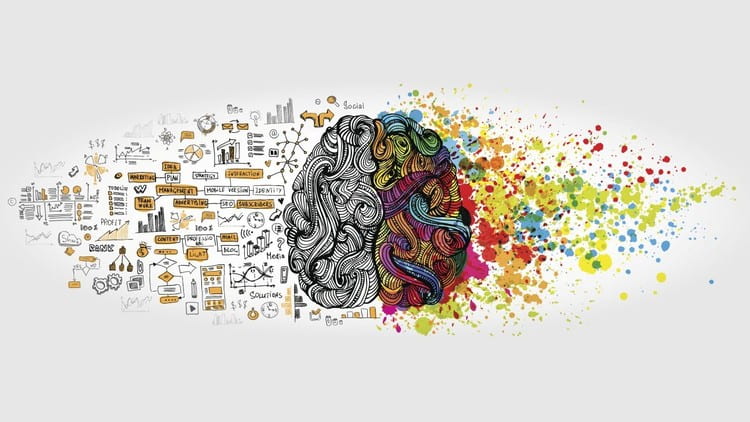 This is crucial to achieving in the present world considering they will perpetually be presented to a kind of wisdom in which they will have to operate between others’ thoughts. Such an importance creates trust and self-confidence, which, in change, stimulate the learner to take more complicated puzzles and questions. If we combine the constructivist approach to the educational system in Turkey, it empowers learners to be prosperous in the area of science. Moreover, by advancing to the curriculum differences from fundamental education in Turkey, which is more efficient in the classroom in the structure of a constructivist approach, intended to improve its creativity. This development was put into use immediately, educators and administrators were encouraged and equipped with the required devices. For instance, the pupil appears to have perpetually internalized the examination from the group construction. Because it needs to get the work and opportunity to challenge and build its own experience. In the turkey educational system, regrettably, it is not straightforward to illustrate a comfortable position to do that because of the anxiety of incompetency. Therefore, previously their own system it is based on the thought of getting the instructor statements without doubting. Shortly, learners do not present questions they are simply attempting to achieve their education by utilizing the knowledge acquired from their instructors.
This is crucial to achieving in the present world considering they will perpetually be presented to a kind of wisdom in which they will have to operate between others’ thoughts. Such an importance creates trust and self-confidence, which, in change, stimulate the learner to take more complicated puzzles and questions. If we combine the constructivist approach to the educational system in Turkey, it empowers learners to be prosperous in the area of science. Moreover, by advancing to the curriculum differences from fundamental education in Turkey, which is more efficient in the classroom in the structure of a constructivist approach, intended to improve its creativity. This development was put into use immediately, educators and administrators were encouraged and equipped with the required devices. For instance, the pupil appears to have perpetually internalized the examination from the group construction. Because it needs to get the work and opportunity to challenge and build its own experience. In the turkey educational system, regrettably, it is not straightforward to illustrate a comfortable position to do that because of the anxiety of incompetency. Therefore, previously their own system it is based on the thought of getting the instructor statements without doubting. Shortly, learners do not present questions they are simply attempting to achieve their education by utilizing the knowledge acquired from their instructors.
In conclusion, I believe the most productive approach is constructivism in Turkey education system because learners connect attention to the assumptions, methods, and techniques in conformity with the opinions of the learner, can improve the content of the course. Not only for learners but also for instructors it is advantageous. It permits learners to be as pleasant as potential in the educational environment, supporting them to produce autonomous production abilities and provides for action and deracination expected by learning exercises indoors in the classroom. It authorizes activities that permit learners to understand and discover their own errors and inconsistencies in their beliefs. Learners understand and apply their errors as an excuse to learn their mistakes. The constructivism is a knowledge and education theory which addresses personalities actively construct and shape their own existence.

 There are many little things that make up the different Southern dialects. The thing that people notice most often is the southern drawl. Drawl mostly means that the sounds are drawn out, especially vowel sounds, but sometimes includes an extra schwa sound in some pronunciations. But there is much more to it than that. Southern speakers pronounce many words differently.- For example, the word where is pronounced with a ‘hw’ sound in the front. This used to be normal in English but only southerners have retained the pronunciation. There are many other pronunciation differences. Many other things that are part of the “accent” are different words and phrases that we use.
There are many little things that make up the different Southern dialects. The thing that people notice most often is the southern drawl. Drawl mostly means that the sounds are drawn out, especially vowel sounds, but sometimes includes an extra schwa sound in some pronunciations. But there is much more to it than that. Southern speakers pronounce many words differently.- For example, the word where is pronounced with a ‘hw’ sound in the front. This used to be normal in English but only southerners have retained the pronunciation. There are many other pronunciation differences. Many other things that are part of the “accent” are different words and phrases that we use. Southerners are typically more laid back and that is reflected in the speech which has drawn-out vowel sounds. You will also notice words that run together like gonna (going to) and lem-me (let me).
Southerners are typically more laid back and that is reflected in the speech which has drawn-out vowel sounds. You will also notice words that run together like gonna (going to) and lem-me (let me).
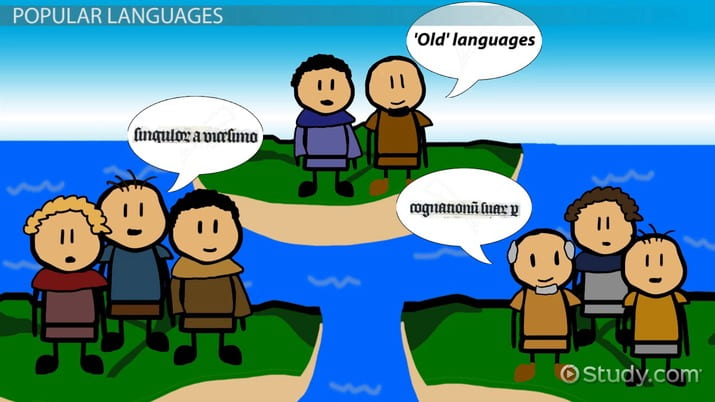 Vernacular is the language of a particular group, profession, region, or country, mainly as spoken rather than formally written. According to the book that is written by Ronald Wardhaugh and Janet M. Fuller, it says that linguists use the term vernacular to refer to the language a person grows up with and uses in everyday life in ordinary, commonplace, social interactions. We should note that so-called vernaculars may meet with social disapproval from others who favour another variety, especially if they prefer a variety heavily influenced by the written form of the language. Therefore, this term often has pejorative associations when used in public discourse. I’ve never been to England in my life. I hope one day I will go, but I guess when I watch the series such as the crown, the Tudors, the white princess, or read the old classics, I realized that the way of writing and speaking was quite different from the way we speak today. For instance, in the 14th century, in poems were written ‘whan’ instead of writing ‘when’, indicating a different vernacular style. Because ‘whan’ belongs to Middle English. Even this shows that this is very different from our writing style. We send emails, tweets, and write new posts for our blogs on the internet. Isn’t different the speaking and writing style that we use today than the 14th century’s vernacular? We send emails, tweets, and write new posts for our blogs on the internet. Isn’t different the speaking and writing style that we use today than the 14th century’s vernacular? Yes, it is. Although this is not a political approach, the new vernacular represents reformist people, propaganda against the royal family’s pretentious style of speech and literary ambiance. It is sincere and plain. We can just say ‘what’s up, man?’ instead of saying ‘how art thee?’
Vernacular is the language of a particular group, profession, region, or country, mainly as spoken rather than formally written. According to the book that is written by Ronald Wardhaugh and Janet M. Fuller, it says that linguists use the term vernacular to refer to the language a person grows up with and uses in everyday life in ordinary, commonplace, social interactions. We should note that so-called vernaculars may meet with social disapproval from others who favour another variety, especially if they prefer a variety heavily influenced by the written form of the language. Therefore, this term often has pejorative associations when used in public discourse. I’ve never been to England in my life. I hope one day I will go, but I guess when I watch the series such as the crown, the Tudors, the white princess, or read the old classics, I realized that the way of writing and speaking was quite different from the way we speak today. For instance, in the 14th century, in poems were written ‘whan’ instead of writing ‘when’, indicating a different vernacular style. Because ‘whan’ belongs to Middle English. Even this shows that this is very different from our writing style. We send emails, tweets, and write new posts for our blogs on the internet. Isn’t different the speaking and writing style that we use today than the 14th century’s vernacular? We send emails, tweets, and write new posts for our blogs on the internet. Isn’t different the speaking and writing style that we use today than the 14th century’s vernacular? Yes, it is. Although this is not a political approach, the new vernacular represents reformist people, propaganda against the royal family’s pretentious style of speech and literary ambiance. It is sincere and plain. We can just say ‘what’s up, man?’ instead of saying ‘how art thee?’ It is sometimes used as an important criterion for distinguishing languages from dialects, although sociolinguistic factors are often also used. Intelligibility between languages can be asymmetric, with speakers of one understanding more of the other than speakers of the other understanding the first. Usually, when speakers understand one another, it is considered a dialect, on the other hand when speakers cannot understand of each other’s languages, they are regarded as separate languages, but when it comes to further classify them as languages into dialects and varieties, mutual intelligibility is not enough. In the textbook, an example is given. I will share it because I liked the example. For example, some speakers of (standard) German can understand (standard) Dutch, while others may find it incomprehensible. In general, Turkic languages are intelligible in changing degrees. Mainly Turkish and Azerbaijani are just like two accents; like British English and American English; mutually intelligible. But even so, it seems that Turkish and Azerbaijani are two different languages. However, while the Azeri language is a Turkish dialect, it is perceived as a language by some people. An Azerbaijani may say, ‘I speak Azerbaijani.’ He does not say ‘I speak Turkish dialect’. I think it is because of the fact that a language, to be distinctive needs a linguistic boundary to reinforce a political barrier. Turkey and Azerbaijan being two different countries not only have uniquely different cultures but also language standards and literary context that makes them worthy of being considered distinct languages. This ideal is based on a sociopolitical ideology of the language, and on different social identifications of the speakers, not on any clear and objective linguistic difference.
It is sometimes used as an important criterion for distinguishing languages from dialects, although sociolinguistic factors are often also used. Intelligibility between languages can be asymmetric, with speakers of one understanding more of the other than speakers of the other understanding the first. Usually, when speakers understand one another, it is considered a dialect, on the other hand when speakers cannot understand of each other’s languages, they are regarded as separate languages, but when it comes to further classify them as languages into dialects and varieties, mutual intelligibility is not enough. In the textbook, an example is given. I will share it because I liked the example. For example, some speakers of (standard) German can understand (standard) Dutch, while others may find it incomprehensible. In general, Turkic languages are intelligible in changing degrees. Mainly Turkish and Azerbaijani are just like two accents; like British English and American English; mutually intelligible. But even so, it seems that Turkish and Azerbaijani are two different languages. However, while the Azeri language is a Turkish dialect, it is perceived as a language by some people. An Azerbaijani may say, ‘I speak Azerbaijani.’ He does not say ‘I speak Turkish dialect’. I think it is because of the fact that a language, to be distinctive needs a linguistic boundary to reinforce a political barrier. Turkey and Azerbaijan being two different countries not only have uniquely different cultures but also language standards and literary context that makes them worthy of being considered distinct languages. This ideal is based on a sociopolitical ideology of the language, and on different social identifications of the speakers, not on any clear and objective linguistic difference.

 Possible interpretations for the symbol.
Possible interpretations for the symbol.


 Slavery
Slavery 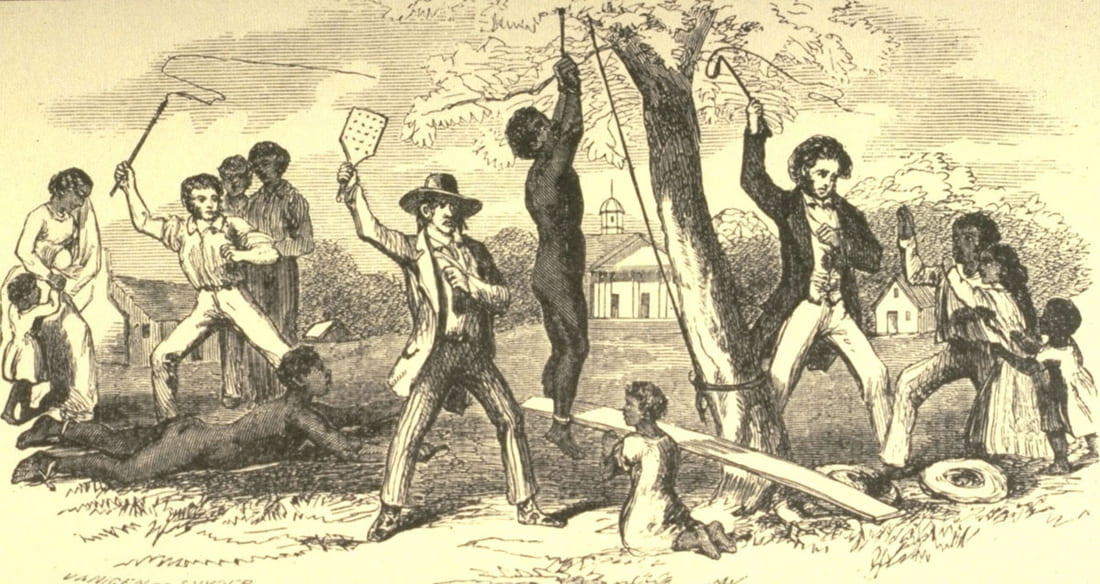
 As the Confederacy’s future president, he started his way with becoming one of Mississippi’s wealthiest and most powerful men The South wanted to remain an agricultural territory; therefore there were strong reasons for seeing the persistence of slavery as an institution without restrictions or disruption.
As the Confederacy’s future president, he started his way with becoming one of Mississippi’s wealthiest and most powerful men The South wanted to remain an agricultural territory; therefore there were strong reasons for seeing the persistence of slavery as an institution without restrictions or disruption.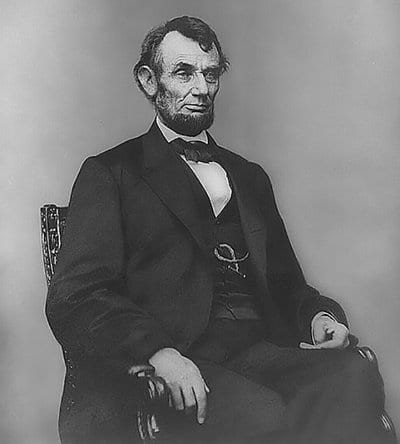 During the Civil War, Abraham Lincoln was the president of the United States. He was against slavery and wanted a greater federal government. His election initiated the departure of the southern states and the Civil War. He’s been determined to keep the country united.
During the Civil War, Abraham Lincoln was the president of the United States. He was against slavery and wanted a greater federal government. His election initiated the departure of the southern states and the Civil War. He’s been determined to keep the country united. The Civil War was the deadliest war in American history. Over 600,000 soldiers died in the war. The fighting started at Fort Sumter in South Carolina on April 12, 1861. The Civil War ended on April 9, 1865 when General Robert E. Lee surrendered to Ulysses S. Grant at the Appomattox Court House in Virginia.
The Civil War was the deadliest war in American history. Over 600,000 soldiers died in the war. The fighting started at Fort Sumter in South Carolina on April 12, 1861. The Civil War ended on April 9, 1865 when General Robert E. Lee surrendered to Ulysses S. Grant at the Appomattox Court House in Virginia. Getting a double major usually means one thing: you’re studying for two degrees at the same time. The details of exactly what that looks like during your time in school will vary. It’s a good idea to talk to your advisor about the specifics for your school and the programs you’re interested in. If you graduate with a double major, you get to list two degrees on your resume. Say, for example, that you majored in both psychology and sociology. On your resume you can list the following:
Getting a double major usually means one thing: you’re studying for two degrees at the same time. The details of exactly what that looks like during your time in school will vary. It’s a good idea to talk to your advisor about the specifics for your school and the programs you’re interested in. If you graduate with a double major, you get to list two degrees on your resume. Say, for example, that you majored in both psychology and sociology. On your resume you can list the following: While it can open up your career opportunities after graduation, there are definitely some challenges with double majoring.
While it can open up your career opportunities after graduation, there are definitely some challenges with double majoring. Learning as much as possible
Learning as much as possible This week, I read two chapters from the book of how to teach English which is written by Jeremy Harmer, and I read two chapters which are about how to manage the classroom and how to plan lessons. So, I can say that I have learned many important topics. The first chapter was about classroom management, and it was saying that classroom management refers to the wide range of skills and strategies used by teachers to keep students coordinated, structured, concentrated, attentive, task-oriented, and academically successful during a class. Moreover, teachers, physical presence can play a large part in our management of the classroom environment. Teachers need to consider how close they should be, how they should behave, how should they use and move around the classroom space. Also, the teacher must be aware of what the students are doing and how they feel as far as possible. It means just as consciously watching and listening while teaching. Secondly, using the voice is also prominent. The value of their speech is not understood by many educators. Yet, when they do, they are likely to develop different ways to improve the learning rate of their students. There are many ways in which you can use voice as an effective teaching device. To be clear, there is no need to yell to be audible. It is both daunting and helpful for students to communicate too loudly or too softly. If teachers want their learners to be silent, they use very loud voices. But it is worth noting that speaking softly is as successful at times as attracting the attention of learners. When students know that you’re saying something, they’ll want to hear for sure. It is so important that teachers change their voices throughout the day, avoiding louder talking or shouting to preserve their energy One of the things that teachers must prepare during their lessons must be to maintain the voice. Thirdly, Teaching is, above all, a communication career. It is the duty of the educator to use classroom management to effectively communicate with students concepts, material, guidance, reviews, and expectations. Students are placed in a position to succeed if teachers do well. Fourthly, Therefore, the best lessons are those where STT (Student talking time) is greatly increased than TTT, but where the teacher is not afraid to explain what is happening, create a story or enter into conversation. To achieve the right balance, good teachers use their common sense and experience. In the classroom where a second language is learned, it is appropriate to use the first language for classroom management. There was something I found right when I read that part, and it was this; Using the translation process in the manner described above does not mean a return to a standard grammar-translation procedure, but rather that, from time to time, using the LI of the learners can allow them to see the similarities and discrepancies between the LI and the L2, and that sometimes the use of the LI by the instructor will enable them to understand things they find difficult to comprehend. Additionally, Once teachers arrive in the classroom, the lesson needs to be started in such a manner that the curiosity of the students is stimulated in order to engage learners. Wherever necessary and relevant, they will tell the students what they are going to do or share with the students what they can learn as a result of what they are going to do in a particular kind of class. In the classroom, It is important to create various seating choices (orderly rows, horseshoes, circles, and separate tables.) It is also important for having group work, pair-work, solo work, whole-class, and class-to-class groupings.
This week, I read two chapters from the book of how to teach English which is written by Jeremy Harmer, and I read two chapters which are about how to manage the classroom and how to plan lessons. So, I can say that I have learned many important topics. The first chapter was about classroom management, and it was saying that classroom management refers to the wide range of skills and strategies used by teachers to keep students coordinated, structured, concentrated, attentive, task-oriented, and academically successful during a class. Moreover, teachers, physical presence can play a large part in our management of the classroom environment. Teachers need to consider how close they should be, how they should behave, how should they use and move around the classroom space. Also, the teacher must be aware of what the students are doing and how they feel as far as possible. It means just as consciously watching and listening while teaching. Secondly, using the voice is also prominent. The value of their speech is not understood by many educators. Yet, when they do, they are likely to develop different ways to improve the learning rate of their students. There are many ways in which you can use voice as an effective teaching device. To be clear, there is no need to yell to be audible. It is both daunting and helpful for students to communicate too loudly or too softly. If teachers want their learners to be silent, they use very loud voices. But it is worth noting that speaking softly is as successful at times as attracting the attention of learners. When students know that you’re saying something, they’ll want to hear for sure. It is so important that teachers change their voices throughout the day, avoiding louder talking or shouting to preserve their energy One of the things that teachers must prepare during their lessons must be to maintain the voice. Thirdly, Teaching is, above all, a communication career. It is the duty of the educator to use classroom management to effectively communicate with students concepts, material, guidance, reviews, and expectations. Students are placed in a position to succeed if teachers do well. Fourthly, Therefore, the best lessons are those where STT (Student talking time) is greatly increased than TTT, but where the teacher is not afraid to explain what is happening, create a story or enter into conversation. To achieve the right balance, good teachers use their common sense and experience. In the classroom where a second language is learned, it is appropriate to use the first language for classroom management. There was something I found right when I read that part, and it was this; Using the translation process in the manner described above does not mean a return to a standard grammar-translation procedure, but rather that, from time to time, using the LI of the learners can allow them to see the similarities and discrepancies between the LI and the L2, and that sometimes the use of the LI by the instructor will enable them to understand things they find difficult to comprehend. Additionally, Once teachers arrive in the classroom, the lesson needs to be started in such a manner that the curiosity of the students is stimulated in order to engage learners. Wherever necessary and relevant, they will tell the students what they are going to do or share with the students what they can learn as a result of what they are going to do in a particular kind of class. In the classroom, It is important to create various seating choices (orderly rows, horseshoes, circles, and separate tables.) It is also important for having group work, pair-work, solo work, whole-class, and class-to-class groupings. The second chapter was about lesson planning, and according to what I learned, Lesson planning is a significant element of the teaching-learning system. A lesson plan is a step-by-step guide offering an effective teaching framework. It is important to identify the learning outcomes for the class before scheduling a lecture. It is important because it helps the instructor to retain a standard pattern of teaching and does not encourage the class to deviate from the subject. Pre-planning helps the teacher to be better equipped in answering questions asked by the students during the lecture. A successful lesson plan has three basic components; curriculum goals and objectives, teaching and learning exercises, and tests to test student understanding of the subject. The lesson’s learning consequences should be about what the learners will have learned by the end, but educators will only really understand what those results are once the curriculum itself has been finished. In other words, how strictly lesson plans are being practiced depends on what happens as teachers try to get them to work. Good teachers must be reasonably agile to deal with unforeseen events, and a good lesson must involve a judicious combination of coherence and variety. First of all, students must know whom they are going to teach and predict different styles of learning (visual, auditory, tactile, and combination). A learning objective is a concept that gives a detailed description of what learners can do after a class. It is the teacher’s role to help students understand how to use the information they will learn during the lesson in a pragmatic way. The lesson plan is a resource for educators to ensure that the learning goals set by teachers are achieved in the time allowed for their students. Identifying the learning goals for both the whole unit plan and each student lesson plan is helpful. Having these total and precise targets can aid in the process of lesson sequencing. Using topic-linking, giving a possibility to predict for students, at the teaching sequence stage, we must ensure that our three elements are present, interact, review and trigger in their different variations. Finally, it is important to plan upcoming lessons based on what has happened before and to use student input and teachers ‘ own experience to inform future decisions of educators.
The second chapter was about lesson planning, and according to what I learned, Lesson planning is a significant element of the teaching-learning system. A lesson plan is a step-by-step guide offering an effective teaching framework. It is important to identify the learning outcomes for the class before scheduling a lecture. It is important because it helps the instructor to retain a standard pattern of teaching and does not encourage the class to deviate from the subject. Pre-planning helps the teacher to be better equipped in answering questions asked by the students during the lecture. A successful lesson plan has three basic components; curriculum goals and objectives, teaching and learning exercises, and tests to test student understanding of the subject. The lesson’s learning consequences should be about what the learners will have learned by the end, but educators will only really understand what those results are once the curriculum itself has been finished. In other words, how strictly lesson plans are being practiced depends on what happens as teachers try to get them to work. Good teachers must be reasonably agile to deal with unforeseen events, and a good lesson must involve a judicious combination of coherence and variety. First of all, students must know whom they are going to teach and predict different styles of learning (visual, auditory, tactile, and combination). A learning objective is a concept that gives a detailed description of what learners can do after a class. It is the teacher’s role to help students understand how to use the information they will learn during the lesson in a pragmatic way. The lesson plan is a resource for educators to ensure that the learning goals set by teachers are achieved in the time allowed for their students. Identifying the learning goals for both the whole unit plan and each student lesson plan is helpful. Having these total and precise targets can aid in the process of lesson sequencing. Using topic-linking, giving a possibility to predict for students, at the teaching sequence stage, we must ensure that our three elements are present, interact, review and trigger in their different variations. Finally, it is important to plan upcoming lessons based on what has happened before and to use student input and teachers ‘ own experience to inform future decisions of educators.



 The subject matter depends on how they define language proficiency. We talk about language as though it had concrete existence and could be measured by scientific instruments. The identify language impairments, language delay, and language precocity without ever specifying the standard against which these cases are to be judged. Although these questions may seem to be prior to any use of language as a research instrument or conclusion about language ability in individuals, they rarely if ever are explicitly addressed. The two major perspectives in linguistic theory are formal and functional approaches. The important point is that each perspective considers different linguistic dimensions to be essential. Therefore, for each orientation, the criteria for determining language proficiency are rooted in different domains. For formal linguistic theories, language proficiency is the reflection of circumscribed and specialized knowledge that is an elaboration of an abstract template. for functional linguistic theories, language proficiency is the reflection of cognitive processes that extracts regularities from the environment and to record those generalities as knowledge. In this sense, linguistic knowledge is no different from other kinds of knowledge of the world. So, there is no doubt that these are different conceptions of language proficiency. For formalists, language is defined by its structure; for functionalists, it is defined by its meanings.
The subject matter depends on how they define language proficiency. We talk about language as though it had concrete existence and could be measured by scientific instruments. The identify language impairments, language delay, and language precocity without ever specifying the standard against which these cases are to be judged. Although these questions may seem to be prior to any use of language as a research instrument or conclusion about language ability in individuals, they rarely if ever are explicitly addressed. The two major perspectives in linguistic theory are formal and functional approaches. The important point is that each perspective considers different linguistic dimensions to be essential. Therefore, for each orientation, the criteria for determining language proficiency are rooted in different domains. For formal linguistic theories, language proficiency is the reflection of circumscribed and specialized knowledge that is an elaboration of an abstract template. for functional linguistic theories, language proficiency is the reflection of cognitive processes that extracts regularities from the environment and to record those generalities as knowledge. In this sense, linguistic knowledge is no different from other kinds of knowledge of the world. So, there is no doubt that these are different conceptions of language proficiency. For formalists, language is defined by its structure; for functionalists, it is defined by its meanings. 
 We need to make to construct of language proficiency stand still long enough to be a meaningful measure of the knowledge and skill individuals have with language. The intention here is not to solve the problem but rather to simply point to approaches that may eventually provide a fruitful resolution. One way to take account of these perspectives is to adopt a process-oriented approach to language proficiency based on identifiable cognitive operations. This method would ideally set the boundaries of proficiency, acknowledge variability, but still provide some metrics for gauging and learners position, preferably on the number of dimensions.
We need to make to construct of language proficiency stand still long enough to be a meaningful measure of the knowledge and skill individuals have with language. The intention here is not to solve the problem but rather to simply point to approaches that may eventually provide a fruitful resolution. One way to take account of these perspectives is to adopt a process-oriented approach to language proficiency based on identifiable cognitive operations. This method would ideally set the boundaries of proficiency, acknowledge variability, but still provide some metrics for gauging and learners position, preferably on the number of dimensions. A clarification of the concept of language proficiency and its cross-lingual dimensions can help resolve a variety of issues related to bilingualism and second language learning. A clarification of the concept of language proficiency and its cross-lingual dimensions can help resolve a variety of issues related to bilingualism and second language learning. There exists a reliable dimension of proficiency in a first language which is strongly related to cognitive skills and which can be empirically distinguished from interpersonal communicative skills such as oral fluency, accent, and socio-linguistic competence.
A clarification of the concept of language proficiency and its cross-lingual dimensions can help resolve a variety of issues related to bilingualism and second language learning. A clarification of the concept of language proficiency and its cross-lingual dimensions can help resolve a variety of issues related to bilingualism and second language learning. There exists a reliable dimension of proficiency in a first language which is strongly related to cognitive skills and which can be empirically distinguished from interpersonal communicative skills such as oral fluency, accent, and socio-linguistic competence. 
 Yes, Sabahattin Ali’s book … I think this is the third book I read. Sabahattin Ali’s first short story collection that makes me feel longing with his poems and tells life with his novels …
Yes, Sabahattin Ali’s book … I think this is the third book I read. Sabahattin Ali’s first short story collection that makes me feel longing with his poems and tells life with his novels …
 He writes so many poems for the young girl, but somehow she is not convinced. The young poet wanders the world for two years. What he sees amazes him. Whereas, nothing changed, what changed was his perception to everything. The things that he looked at before as if it was a virtue, was only spectacle and showing off and that true goodness can only be found in moral argument or wise advices. Without getting dirty, it is enough to advance using the purity of people, and as he sees many more similar things, his astonishment was increasing. He had to see the world to change his ideas. After this journey, he sent his book that he wrote with staying away from people to girl that he loves. The young girl likes this masterpiece and runs to the young man, thinking that it will be the best book ever.
He writes so many poems for the young girl, but somehow she is not convinced. The young poet wanders the world for two years. What he sees amazes him. Whereas, nothing changed, what changed was his perception to everything. The things that he looked at before as if it was a virtue, was only spectacle and showing off and that true goodness can only be found in moral argument or wise advices. Without getting dirty, it is enough to advance using the purity of people, and as he sees many more similar things, his astonishment was increasing. He had to see the world to change his ideas. After this journey, he sent his book that he wrote with staying away from people to girl that he loves. The young girl likes this masterpiece and runs to the young man, thinking that it will be the best book ever.






 A cognitive outlook or approach to the manner of education would be one that offers various activities within which learners can explore and combine knowledge over firsthand preoccupation. In Turkey, although the intentions in the plans were made according to the levels in Bloom taxonomy based on behaviorism, they could not move surpassing understanding and knowledge in teaching and learning. Over time, by overlooking the high-level levels in the taxonomy, the applications are compared to the level of knowledge center level and their foremost assignment is not to obtain information. The education has given it likely to ensure learners with knowledge and remember this knowledge. It shows a conflicting image with its intensity in training. Considerably, if the educational policy in Turkey proceeded forward with this method, learners’ accomplishments may have developed. To define, the part of the instructor in the classroom is to encourage learners to obtain wisdom in this method and support them to retain. Although whereby instructors aim for their learners, the place is becoming critical as instructors process according to the curriculum. To sum up, learners require to apprehend which educational habits are best for them and determine a process by their own training for how to study in an active mode.
A cognitive outlook or approach to the manner of education would be one that offers various activities within which learners can explore and combine knowledge over firsthand preoccupation. In Turkey, although the intentions in the plans were made according to the levels in Bloom taxonomy based on behaviorism, they could not move surpassing understanding and knowledge in teaching and learning. Over time, by overlooking the high-level levels in the taxonomy, the applications are compared to the level of knowledge center level and their foremost assignment is not to obtain information. The education has given it likely to ensure learners with knowledge and remember this knowledge. It shows a conflicting image with its intensity in training. Considerably, if the educational policy in Turkey proceeded forward with this method, learners’ accomplishments may have developed. To define, the part of the instructor in the classroom is to encourage learners to obtain wisdom in this method and support them to retain. Although whereby instructors aim for their learners, the place is becoming critical as instructors process according to the curriculum. To sum up, learners require to apprehend which educational habits are best for them and determine a process by their own training for how to study in an active mode. Thirdly, Social cognitive learning happens when a person learns from other members of the group by examining and repeating their behavior. In order to emulate distinctive person a person has to build a communication connecting this person’s presence and that of his or her own, and this needs a specific level of cognitive improvement. Social cognitive theory is getting symbolic descriptions during observation. The method which is social cognitive learning based on a reflection of perceived behavior. Most frequently compared with the production of Albert Bandura, social learning theory combines systems of both behaviorism and cognitive theories of learning. In its simplistic structure, social learning theory describes how people determine by examining the presence of others. Bandura proposes that this method has four element parts – concentration, memory, machine generation, and impulse. Environmental and cognitive parts can lead the method as well. The system has numerous possible purposes for recognition behavior in the classroom, and in the community more regularly. Nevertheless, notwithstanding its extensive influence, social learning theory is not externally its experts. Education would be the pure social learning we acquire from convening our fundamental social, physical, and emotional demands.
Thirdly, Social cognitive learning happens when a person learns from other members of the group by examining and repeating their behavior. In order to emulate distinctive person a person has to build a communication connecting this person’s presence and that of his or her own, and this needs a specific level of cognitive improvement. Social cognitive theory is getting symbolic descriptions during observation. The method which is social cognitive learning based on a reflection of perceived behavior. Most frequently compared with the production of Albert Bandura, social learning theory combines systems of both behaviorism and cognitive theories of learning. In its simplistic structure, social learning theory describes how people determine by examining the presence of others. Bandura proposes that this method has four element parts – concentration, memory, machine generation, and impulse. Environmental and cognitive parts can lead the method as well. The system has numerous possible purposes for recognition behavior in the classroom, and in the community more regularly. Nevertheless, notwithstanding its extensive influence, social learning theory is not externally its experts. Education would be the pure social learning we acquire from convening our fundamental social, physical, and emotional demands. Nature and nurture, behavior and psychology are associated with each other. It doesn’t speak for the intricacy of human differentiation exceeding recognizing that they endure. It doesn’t concentrate on character attributes, physiological variances, and their state. When interpreting behaviors and their linked cognitive methods. We may assume that in Turkey education system particularly for colleges/educational field this approach could be implemented as a consequence of performing learners acquiring results. This approach is usually applied in informal education. For instance, we may believe of the instructor-learner connection that the instructor who seeks to increase his or her learner acquire practice, learn and perceive for comprehending the situation. In summary, really this approach can be worthwhile in particular fields still in Turkey, the education system does not promote emulating teachers as a function model.
Nature and nurture, behavior and psychology are associated with each other. It doesn’t speak for the intricacy of human differentiation exceeding recognizing that they endure. It doesn’t concentrate on character attributes, physiological variances, and their state. When interpreting behaviors and their linked cognitive methods. We may assume that in Turkey education system particularly for colleges/educational field this approach could be implemented as a consequence of performing learners acquiring results. This approach is usually applied in informal education. For instance, we may believe of the instructor-learner connection that the instructor who seeks to increase his or her learner acquire practice, learn and perceive for comprehending the situation. In summary, really this approach can be worthwhile in particular fields still in Turkey, the education system does not promote emulating teachers as a function model. Fourthly, Constructivism is essentially an approach that is based on research and experimental investigation is about how individuals learn. It states that people create their own perception and understanding of the world, within encountering things and returning with stimuli on those occurrences. When we face something distinct, we have to arrange it with our past thoughts and experience, perhaps developing what we believe, or perhaps rejecting the latest knowledge as unnecessary. In any circumstance, we are engaged producers of our own experience. Ultimately, the learners and instructor lecture about what they have acquired, and how their measurements and analyses supported (or did not support) them to completely grasp the concept. According to all knowledge at the above, constructivist learning theory is the genuine and profitable learning theory between them because learners including learn to create relationships and connections by linking the subject matter to their own life adventure. Learners must acquire how to precisely enunciate their opinions as well as to cooperate on tasks adequately by partaking the load of group projects. Accordingly, swapping opinions and then must receive to “transmit” with others and to assess their participation in a culturally satisfactory practice.
Fourthly, Constructivism is essentially an approach that is based on research and experimental investigation is about how individuals learn. It states that people create their own perception and understanding of the world, within encountering things and returning with stimuli on those occurrences. When we face something distinct, we have to arrange it with our past thoughts and experience, perhaps developing what we believe, or perhaps rejecting the latest knowledge as unnecessary. In any circumstance, we are engaged producers of our own experience. Ultimately, the learners and instructor lecture about what they have acquired, and how their measurements and analyses supported (or did not support) them to completely grasp the concept. According to all knowledge at the above, constructivist learning theory is the genuine and profitable learning theory between them because learners including learn to create relationships and connections by linking the subject matter to their own life adventure. Learners must acquire how to precisely enunciate their opinions as well as to cooperate on tasks adequately by partaking the load of group projects. Accordingly, swapping opinions and then must receive to “transmit” with others and to assess their participation in a culturally satisfactory practice.  This is crucial to achieving in the present world considering they will perpetually be presented to a kind of wisdom in which they will have to operate between others’ thoughts. Such an importance creates trust and self-confidence, which, in change, stimulate the learner to take more complicated puzzles and questions. If we combine the constructivist approach to the educational system in Turkey, it empowers learners to be prosperous in the area of science. Moreover, by advancing to the curriculum differences from fundamental education in Turkey, which is more efficient in the classroom in the structure of a constructivist approach, intended to improve its creativity. This development was put into use immediately, educators and administrators were encouraged and equipped with the required devices. For instance, the pupil appears to have perpetually internalized the examination from the group construction. Because it needs to get the work and opportunity to challenge and build its own experience. In the turkey educational system, regrettably, it is not straightforward to illustrate a comfortable position to do that because of the anxiety of incompetency. Therefore, previously their own system it is based on the thought of getting the instructor statements without doubting. Shortly, learners do not present questions they are simply attempting to achieve their education by utilizing the knowledge acquired from their instructors.
This is crucial to achieving in the present world considering they will perpetually be presented to a kind of wisdom in which they will have to operate between others’ thoughts. Such an importance creates trust and self-confidence, which, in change, stimulate the learner to take more complicated puzzles and questions. If we combine the constructivist approach to the educational system in Turkey, it empowers learners to be prosperous in the area of science. Moreover, by advancing to the curriculum differences from fundamental education in Turkey, which is more efficient in the classroom in the structure of a constructivist approach, intended to improve its creativity. This development was put into use immediately, educators and administrators were encouraged and equipped with the required devices. For instance, the pupil appears to have perpetually internalized the examination from the group construction. Because it needs to get the work and opportunity to challenge and build its own experience. In the turkey educational system, regrettably, it is not straightforward to illustrate a comfortable position to do that because of the anxiety of incompetency. Therefore, previously their own system it is based on the thought of getting the instructor statements without doubting. Shortly, learners do not present questions they are simply attempting to achieve their education by utilizing the knowledge acquired from their instructors.














 Kommt vom “Toren” personen ab, einem altdeutschen Wort für jemanden, der dumm handelt. Ein exempel: “Wenn du in acht Stunden arbeiten musst, wäre eine neue Serie starten nun ganz töricht”
Kommt vom “Toren” personen ab, einem altdeutschen Wort für jemanden, der dumm handelt. Ein exempel: “Wenn du in acht Stunden arbeiten musst, wäre eine neue Serie starten nun ganz töricht” Ein weiter Nachkomme des “Muffensausens”, meinet so viel wie “Angst” oder “Sorge”. Bekommt dir auf das Gefühl von Anspannung in den eigenen Klamotten. Nur leider dominieren Fracks die Alltagskleidung nicht mehr besonders.
Ein weiter Nachkomme des “Muffensausens”, meinet so viel wie “Angst” oder “Sorge”. Bekommt dir auf das Gefühl von Anspannung in den eigenen Klamotten. Nur leider dominieren Fracks die Alltagskleidung nicht mehr besonders. Tiernamen als Beleidigungen sind generell aus der Mode gefallen, genau wie “du Esel”, “du Kamel” oder “du Rhinozeros”. “Du Hornochse” ist aber selbst unter diesen ein besonders auffallend Fluch. Als Schimpfwort wurde es gebraucht, weil das Nutztier als besonders grobschlächtig und unsensibel gilt.
Tiernamen als Beleidigungen sind generell aus der Mode gefallen, genau wie “du Esel”, “du Kamel” oder “du Rhinozeros”. “Du Hornochse” ist aber selbst unter diesen ein besonders auffallend Fluch. Als Schimpfwort wurde es gebraucht, weil das Nutztier als besonders grobschlächtig und unsensibel gilt. Etwas Vertrauliches erzählen. Der Begriff ist nah am Wort “ausplaudern”, klingt aber durch das wundervoll poetische “plappern” noch einmal extra-frisch. Das ist übrigens ein Wort, das sich lautmalerisch von “Blabla” ableitet.
Etwas Vertrauliches erzählen. Der Begriff ist nah am Wort “ausplaudern”, klingt aber durch das wundervoll poetische “plappern” noch einmal extra-frisch. Das ist übrigens ein Wort, das sich lautmalerisch von “Blabla” ableitet. Jemanden veralbern. Dieser Begriff hat eine seltsame Herkunft: Er stammt von niedersächsischen Waffelverkäufern – den sogenannten “holen Hippen” aus dem 16. Jahrhundert ab, denen nachgesagt wurde, während des Verkaufs von Haus zu Haus über ihre Kunden zu lästern.
Jemanden veralbern. Dieser Begriff hat eine seltsame Herkunft: Er stammt von niedersächsischen Waffelverkäufern – den sogenannten “holen Hippen” aus dem 16. Jahrhundert ab, denen nachgesagt wurde, während des Verkaufs von Haus zu Haus über ihre Kunden zu lästern. Ein großer Mann mit schlechter Körperhaltung. Eigentlich zuerst auf das Schlurfen bezogen, ist bis heute nicht ganz geklärt, woher das “Lu” kommt. Denn dass “Latsch” von “latschen” und damit vom Gehen stammt, kann man sich ja denken.
Ein großer Mann mit schlechter Körperhaltung. Eigentlich zuerst auf das Schlurfen bezogen, ist bis heute nicht ganz geklärt, woher das “Lu” kommt. Denn dass “Latsch” von “latschen” und damit vom Gehen stammt, kann man sich ja denken.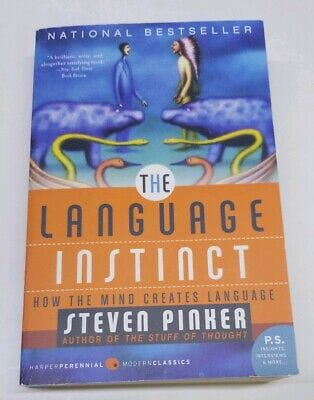 A great intro/primer to some of the more basic questions in linguistics. The Language Instinct sets out to explain Chomsky, along with some other ideas less acceptable to him. It is a challenging, sometimes rambunctious read, made viable for the non- specialist by its entertaining style and culling from ordinary speech, children’s early speech, ambiguous newspaper headlines, popular songs and literary works. Pinker stoutly maintains that the ability to speak is no different in origin from, say, the ability to see. The organs of speech and the eye have evolved, he says, by natural selection, as first envisaged by Darwin. Language is unique to humans, he concedes, unlike eyes, but that does not bother him: ‘A language instinct unique to modern humans poses no more of a paradox than a trunk unique to modern elephants.’ Further on, he claims that the language instinct impresses him no more or less than the island-building instinct of corals or the photosynthesizing instinct of bacteria. Yet, almost in the same breath, he admits: ‘Most objects in the universe – lakes, rocks, trees, worms, cows, cars – cannot talk . . .
A great intro/primer to some of the more basic questions in linguistics. The Language Instinct sets out to explain Chomsky, along with some other ideas less acceptable to him. It is a challenging, sometimes rambunctious read, made viable for the non- specialist by its entertaining style and culling from ordinary speech, children’s early speech, ambiguous newspaper headlines, popular songs and literary works. Pinker stoutly maintains that the ability to speak is no different in origin from, say, the ability to see. The organs of speech and the eye have evolved, he says, by natural selection, as first envisaged by Darwin. Language is unique to humans, he concedes, unlike eyes, but that does not bother him: ‘A language instinct unique to modern humans poses no more of a paradox than a trunk unique to modern elephants.’ Further on, he claims that the language instinct impresses him no more or less than the island-building instinct of corals or the photosynthesizing instinct of bacteria. Yet, almost in the same breath, he admits: ‘Most objects in the universe – lakes, rocks, trees, worms, cows, cars – cannot talk . . . A very inclusive introduction into the fields of linguistics, starts off with origins of language, aspects of language that is, phonetics phonology morphology, syntax and semantics, gives a wonderful basic explanation of the function of each. and then goes on to the wonderful stuff of applied linguistics, discourse analysis, pragmatics, first language acquisition, second language, language change, sign language, sociolinguistics and language and culture. regrettably no chapters on psycho-linguistics. however over all a wonderful and fun guide on the many facets of linguistics and it’s use as a tool to understand humanity. Moreover, this is a fantastic book that is perfect for someone with zero background knowledge in linguistics. It begins with the origins of language and moves on to discuss the differences between animal “language” and human language, eventually touching on more complex linguistic concepts (morphology, syntax, pragmatics, semantics). There are plenty of diagrams and charts to help the reader understand these terms and ideas, which were really helpful to me as someone with no prior linguistics instruction. After describing the more technical aspects of language, Yule touches on the differences between first and second language acquisition, bilingualism, written language, and the ways English has developed over time in both regional and socio-economic terms. I like that Yule draws attention to commonly neglected types of English as well, like AAVE, English-based creole, and pidgin; these language forms are often overlooked despite their history and modern, social significance.
A very inclusive introduction into the fields of linguistics, starts off with origins of language, aspects of language that is, phonetics phonology morphology, syntax and semantics, gives a wonderful basic explanation of the function of each. and then goes on to the wonderful stuff of applied linguistics, discourse analysis, pragmatics, first language acquisition, second language, language change, sign language, sociolinguistics and language and culture. regrettably no chapters on psycho-linguistics. however over all a wonderful and fun guide on the many facets of linguistics and it’s use as a tool to understand humanity. Moreover, this is a fantastic book that is perfect for someone with zero background knowledge in linguistics. It begins with the origins of language and moves on to discuss the differences between animal “language” and human language, eventually touching on more complex linguistic concepts (morphology, syntax, pragmatics, semantics). There are plenty of diagrams and charts to help the reader understand these terms and ideas, which were really helpful to me as someone with no prior linguistics instruction. After describing the more technical aspects of language, Yule touches on the differences between first and second language acquisition, bilingualism, written language, and the ways English has developed over time in both regional and socio-economic terms. I like that Yule draws attention to commonly neglected types of English as well, like AAVE, English-based creole, and pidgin; these language forms are often overlooked despite their history and modern, social significance. The well of English wit at times seems inexhaustible both as culture and as language. The Etymologicon is one such time. It is the Oxford English Dictionary transcribed into precise short stories; Joyce’s Finnegans Wake explained; Samuel Johnson’s Dictionary annotated; and Wittgenstein’s Red and Blue Books vindicated. Words connect only to other words and nothing else. But this makes them more not less useful. It means that meaning can be entirely in our heads. Not in any single head but in ‘our’ head of indeterminate size. And even more remarkably, a head of indeterminate age. All of us who share a language, or a language into which our language may be translated inhabit that head. Did you know that avocados are testicles? And we’re all part of the human gene chicken? And that if you called a Nazi a Nazi they would beat you up? And that the Bluetooth on your phone is a Viking? I read this on my lunch break, devouring the bite-size chapters along with my canteen spam’n’chips… and I couldn’t wait to get home and tell my wife the funny little snipped that had stuck in my mind that day. Each mini-chapter delves into the amusing anecdotes that lay behind everyday words, and end by linking that word on to a new word which will be the focus of the next chapter.
The well of English wit at times seems inexhaustible both as culture and as language. The Etymologicon is one such time. It is the Oxford English Dictionary transcribed into precise short stories; Joyce’s Finnegans Wake explained; Samuel Johnson’s Dictionary annotated; and Wittgenstein’s Red and Blue Books vindicated. Words connect only to other words and nothing else. But this makes them more not less useful. It means that meaning can be entirely in our heads. Not in any single head but in ‘our’ head of indeterminate size. And even more remarkably, a head of indeterminate age. All of us who share a language, or a language into which our language may be translated inhabit that head. Did you know that avocados are testicles? And we’re all part of the human gene chicken? And that if you called a Nazi a Nazi they would beat you up? And that the Bluetooth on your phone is a Viking? I read this on my lunch break, devouring the bite-size chapters along with my canteen spam’n’chips… and I couldn’t wait to get home and tell my wife the funny little snipped that had stuck in my mind that day. Each mini-chapter delves into the amusing anecdotes that lay behind everyday words, and end by linking that word on to a new word which will be the focus of the next chapter.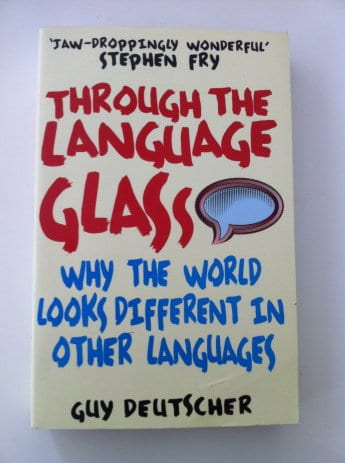 This is a fascinating book about how culture shapes language, and how language shapes our view of reality. Guy Deutscher is a linguist, and he separates out in some detail, the facts of this subject from fiction. Because, there is a lot of “fiction”. Much of what we have heard about how language shapes our world-view is false. Nietzsche’s line that “the limits of my language mean the limits of my world” is absolutely false. A true statement would be “Languages differ in what they must convey, not in what they may convey.” In other words, languages force their speakers to use certain words in describing concepts, but languages do not constrain their speakers from discussing concepts. The fact that a language lacks a word that describes some concept, does not mean that its speakers are unaware of that concept. It just means, probably, that the concept is either not too important in that culture, or that it is so all-encompassing that it does not require a special word. I found the language lens to be absolutely fascinating. It is very difficult for linguists or psychologists to isolate some aspect of a person’s world-view, and to say that it is not only correlated with, but caused by some aspect of his language. But, this has been done definitively in three areas; spatial concepts, gender, and color. For example, in English (and most European languages, I think), there are both ego-centric (up, down, in front, behind, left, right) and geo-centric (North, South, East, West) descriptors. But, some languages only have ego-centric descriptors, while others have only geo-centric words. Ego-centric descriptors are mostly useful in urban areas, such as when you need to give someone directions (go up the elevator to the 5th floor, turn right, pass two doors and take the corridor on the left). In the countryside, geo-centric descriptions might sometimes be more useful (the river running to the south of the lake). The tribes that speak languages that only have geo-centric descriptions learn from a very early age to set up an internal compass. This compass works regardless of visibility conditions; it works in a dense forest, in swamps, sand dunes, and in caves. Only if your transport the speaker of such a language by airplane does he lose his sense of direction. It’s hard to imagine, that such a person will never say “the cow to my left” but instead would say “the cow to the north of me”.
This is a fascinating book about how culture shapes language, and how language shapes our view of reality. Guy Deutscher is a linguist, and he separates out in some detail, the facts of this subject from fiction. Because, there is a lot of “fiction”. Much of what we have heard about how language shapes our world-view is false. Nietzsche’s line that “the limits of my language mean the limits of my world” is absolutely false. A true statement would be “Languages differ in what they must convey, not in what they may convey.” In other words, languages force their speakers to use certain words in describing concepts, but languages do not constrain their speakers from discussing concepts. The fact that a language lacks a word that describes some concept, does not mean that its speakers are unaware of that concept. It just means, probably, that the concept is either not too important in that culture, or that it is so all-encompassing that it does not require a special word. I found the language lens to be absolutely fascinating. It is very difficult for linguists or psychologists to isolate some aspect of a person’s world-view, and to say that it is not only correlated with, but caused by some aspect of his language. But, this has been done definitively in three areas; spatial concepts, gender, and color. For example, in English (and most European languages, I think), there are both ego-centric (up, down, in front, behind, left, right) and geo-centric (North, South, East, West) descriptors. But, some languages only have ego-centric descriptors, while others have only geo-centric words. Ego-centric descriptors are mostly useful in urban areas, such as when you need to give someone directions (go up the elevator to the 5th floor, turn right, pass two doors and take the corridor on the left). In the countryside, geo-centric descriptions might sometimes be more useful (the river running to the south of the lake). The tribes that speak languages that only have geo-centric descriptions learn from a very early age to set up an internal compass. This compass works regardless of visibility conditions; it works in a dense forest, in swamps, sand dunes, and in caves. Only if your transport the speaker of such a language by airplane does he lose his sense of direction. It’s hard to imagine, that such a person will never say “the cow to my left” but instead would say “the cow to the north of me”.

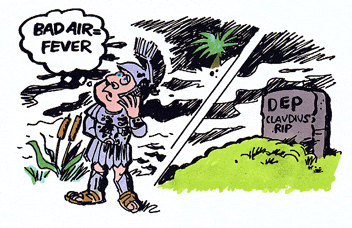




 Another controversial term is “kibosh,” though most claim it can be traced back to Ireland, where a similar-sounding term referred to the so-called “the cap of death,” or the hat that judge would wear when sentencing someone to death. In 1836,
Another controversial term is “kibosh,” though most claim it can be traced back to Ireland, where a similar-sounding term referred to the so-called “the cap of death,” or the hat that judge would wear when sentencing someone to death. In 1836, 


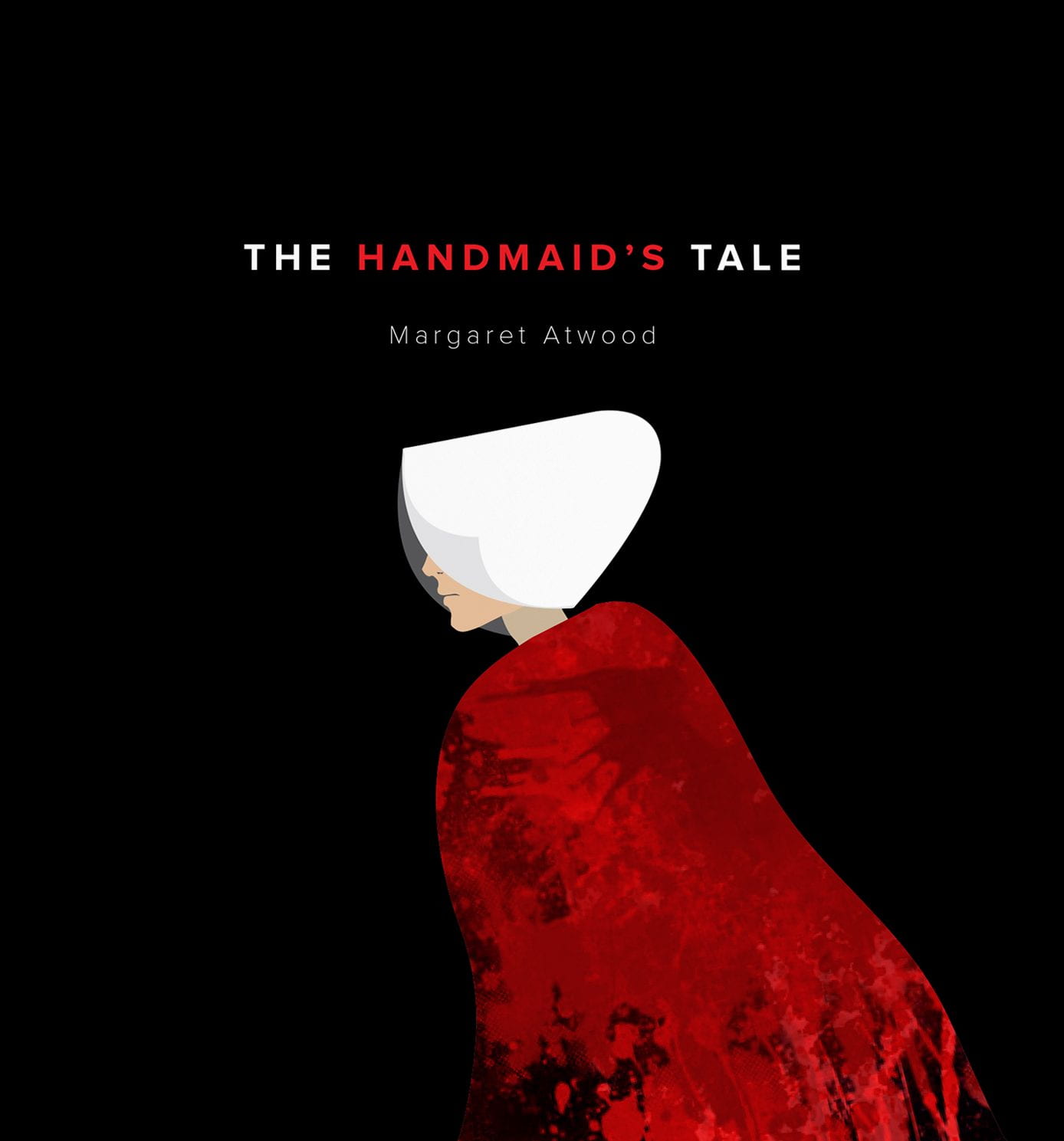

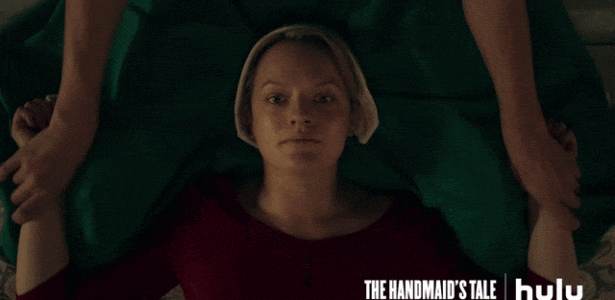









Recent Comments